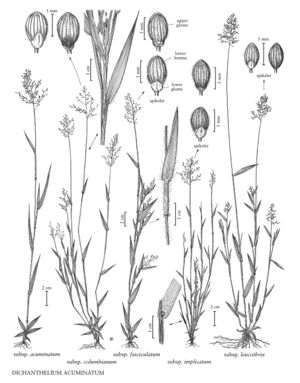Difference between revisions of "Dichanthelium acuminatum subsp. leucothrix"
FNA>Volume Importer |
imported>Volume Importer |
||
| (8 intermediate revisions by 2 users not shown) | |||
| Line 6: | Line 6: | ||
|synonyms={{Treatment/ID/Synonym | |synonyms={{Treatment/ID/Synonym | ||
|name=Panicum leucothrix | |name=Panicum leucothrix | ||
| − | |authority= | + | |authority= |
| − | }}{{Treatment/ID/Synonym | + | |rank=species |
| + | }} {{Treatment/ID/Synonym | ||
|name=Panicum acuminatum var. leucothrix | |name=Panicum acuminatum var. leucothrix | ||
| − | |authority= | + | |authority= |
| + | |rank=variety | ||
}} | }} | ||
|hierarchy=Poaceae;Poaceae subfam. Panicoideae;Poaceae tribe Paniceae;Dichanthelium;Dichanthelium sect. Lanuginosa;Dichanthelium acuminatum;Dichanthelium acuminatum subsp. leucothrix | |hierarchy=Poaceae;Poaceae subfam. Panicoideae;Poaceae tribe Paniceae;Dichanthelium;Dichanthelium sect. Lanuginosa;Dichanthelium acuminatum;Dichanthelium acuminatum subsp. leucothrix | ||
| Line 21: | Line 23: | ||
-->{{Treatment/Body | -->{{Treatment/Body | ||
| − | |discussion=<p>Dichanthelium acuminatum subsp. leucothrix grows in low, sandy or peaty pine savannahs of the coastal plain. Its range extends through Mexico, the West Indies, and Central America to northern South America. It is closely related, and often sympatric with, the more common, glabrous subsp. longiligulatum.</p> | + | |discussion=<p><i>Dichanthelium acuminatum </i>subsp.<i> leucothrix</i> grows in low, sandy or peaty pine savannahs of the coastal plain. Its range extends through Mexico, the West Indies, and Central America to northern South America. It is closely related, and often sympatric with, the more common, glabrous <i></i>subsp.<i> longiligulatum</i>.</p> |
|tables= | |tables= | ||
|references= | |references= | ||
| Line 30: | Line 32: | ||
-->{{#Taxon: | -->{{#Taxon: | ||
name=Dichanthelium acuminatum subsp. leucothrix | name=Dichanthelium acuminatum subsp. leucothrix | ||
| − | |||
|authority=(Nash) Freckmann & Lelong | |authority=(Nash) Freckmann & Lelong | ||
|rank=subspecies | |rank=subspecies | ||
| Line 37: | Line 38: | ||
|basionyms= | |basionyms= | ||
|family=Poaceae | |family=Poaceae | ||
| + | |illustrator=Linda A. Vorobik;Hana Pazdírková | ||
| + | |illustration copyright=Utah State University | ||
|reference=None | |reference=None | ||
|publication title= | |publication title= | ||
|publication year= | |publication year= | ||
|special status= | |special status= | ||
| − | |source xml=https:// | + | |source xml=https://bitbucket.org/aafc-mbb/fna-data-curation/src/200273ad09963decb8fc72550212de541d86569d/coarse_grained_fna_xml/V25/V25_1162.xml |
|subfamily=Poaceae subfam. Panicoideae | |subfamily=Poaceae subfam. Panicoideae | ||
|tribe=Poaceae tribe Paniceae | |tribe=Poaceae tribe Paniceae | ||
Latest revision as of 18:55, 11 May 2021
Plants cespitose, pale olive green, often purplish-tinged. Culms usually 30-100 cm, erect to ascending, sparsely pubescent to almost glabrous, hairs appressed, thin, silvery, papillose-based; nodes sparsely pubescent; fall phase branching extensively from the lower and midculm nodes, with conspicuous, flabellate fascicles of branches and reduced blades. Cauline sheaths shorter than the internodes, sparsely pilose to nearly glabrous, hairs papillose-based, occasionally with shorter soft hairs underneath, margins ciliate; midculm sheaths about 1/2 as long as the internodes; blades usually 2-7 cm long, 2-7 mm wide, relatively firm, ascending, spreading, or reflexed, abaxial surfaces densely and softly puberulent, adaxial surfaces glabrous or sparsely appressed-villous, sometimes with a few longer hairs intermixed. Primary panicles open, long-exserted, dense. Spikelets 1.1-1.5 mm, usually ellipsoid, densely short-pubescent.
Discussion
Dichanthelium acuminatum subsp. leucothrix grows in low, sandy or peaty pine savannahs of the coastal plain. Its range extends through Mexico, the West Indies, and Central America to northern South America. It is closely related, and often sympatric with, the more common, glabrous subsp. longiligulatum.
Selected References
None.
